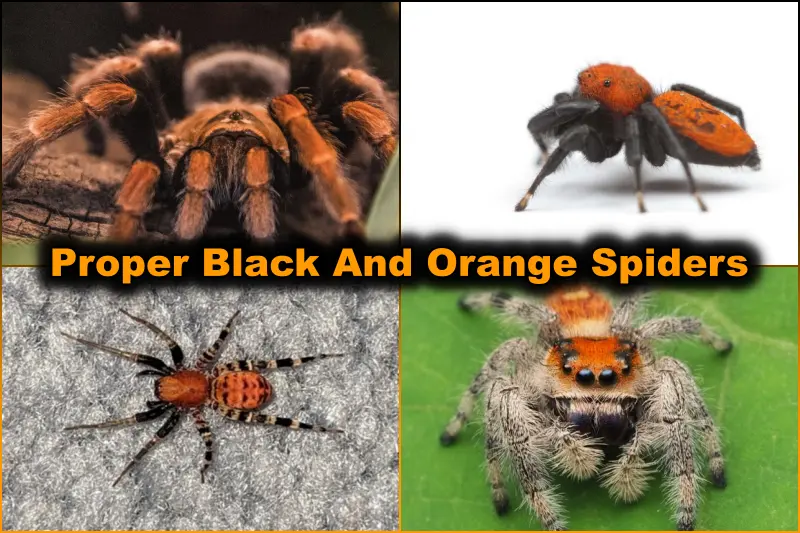You often watch black and orange spiders. But have you ever seen a spider with both colors? Today we are going to look at some beautiful, cute, and adorable orange and black spiders.
The orange and black spiders are not really common, but they are not that much harder to find. They can be found in forests, parks, and green areas. Most of them have proper orange and black colors.
Some of these spiders are venomous. Some are cute, while some look horrible. And this is the time to take a look at all of the spiders. Here are 12 orange and black spider species.
12 Orange And Black Spiders
1. Bold Jumping Spider
| Scientific name | Phidippus audax |
| Size | 6-13 mm |
| Identification | orange triangle on their abdomen |
| Geographical location | The United States, southern Canada, Hawaii, the Nicobar Islands, Azores, Netherlands, and northern Mexico |
Phidippus audax, also known as the bold jumper or bold jumping spider, is a typical species of spider native to North America and introduced to Hawaii, the Nicobar Islands, the Azores, and the Netherlands.
These solitary carnivores use their specialized eyesight to hunt and stalk prey, including insects and non-insect terrestrial arthropods. Adult females range from 8–15 mm in body length, while males are smaller at 6–13 mm.
They are characterized by their ovoid abdomen, round cephalothorax, and distinct orange triangles on their abdomen.
Following the orange triangle, the spider has two orange spots on the lower part of the abdomen.
Adult males have tufts of hair over their eyes, while markings in spiderlings are usually orange and turn white as they mature.
2. Orange Pumpkin Spider
| Scientific name | Araneus marmoreus |
| Size | 9-18 mm |
| Identification | Orange abdomen with patterns on it |
| Geographical location | United States, Europe, and Canada |
The marbled orb-weaver, also known as the pumpkin spider, is a spider species in the Araneidae family. Its unique pattern of colors, including orange and black, makes it attractive.
The female spiders, larger than males, stay in their retreats and lay orange eggs, which are guarded by a silken sac.
Some have an orange and yellow abdomen, while others have black and orange bands.
Despite its large size, the marbled orb weaver is not aggressive towards humans, making it a popular choice for spider enthusiasts.
3. Ladybird Spider
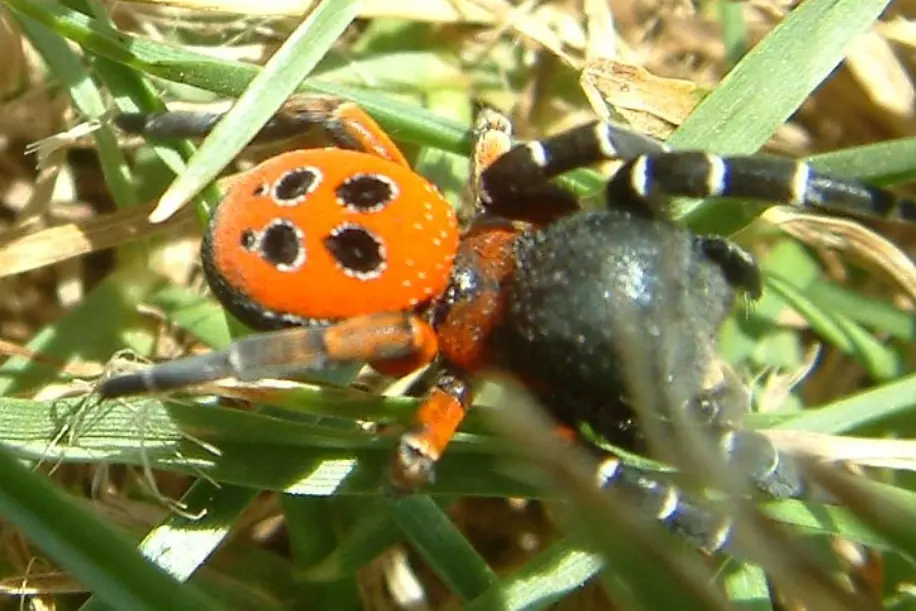
| Scientific name | Eresus sandaliatus |
| Size | 6-16 mm |
| Identification | four large and two small ebony spots |
| Geographical location | northern and central Europe |
Eresus sandaliatus is a spider species primarily found in northern and central Europe. It is known as the ladybird spider due to its male coloration.
Males are 6–9 millimeters long and have a bright orange back with four large and two small ebony spots.
They lack white hair and red legs. Females are 10–16 millimeters long and jet-black. The female spiders are smaller than the males.
4. Splendid Dwarf Spider
| Scientific name | Hypselistes florens |
| Size | 2-3 mm |
| Identification | eight eyes |
| Geographical location | Northern United States and Canada |
The splendid dwarf spider is also known as the Pettland sheet-web weaver. The Pettland sheet-web weaver is a small, eight-eyed spider found in the northern United States and Canada.
It is a seldom-seen species, often found under dead leaves or debris. The male and female spiders have similar shapes and colors, with the female being 2.5–3 mm long and the male being 2–2 mm long.
The cephalothorax, the front part of the body, can be bright orange, dark orange, or orangish-red. The abdomen is dark gray to nearly black, spherical, and shiny. Legs are medium-length and armed with spines.
5. Tortoise orb weaver
| Scientific name | Encyosaccus sexmaculatus |
| Size | approx 8 mm |
| Identification | six black sections on abdomen |
| Geographical location | Colombia, Ecuador, Peru, and Brazil |
Encyosaccus sexmaculatus, a single species of South American orb-weaver spider, is dark orange with a black tarsus and light orange spotted with black on the dorsal side.
It was first described by Eugène Simon in 1895 and is found in Colombia, Ecuador, Peru, and Brazil. The orange area is segmented into six sections by a white border and lines.
6. Mexican Fireleg
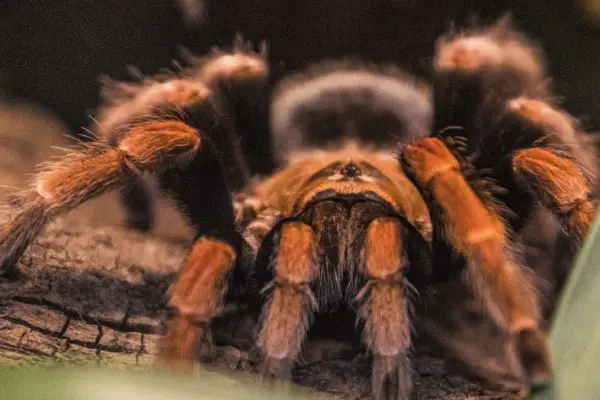
| Scientific name | Brachypelma boehmei |
| Size | 127-152 mm |
| Identification | black bands on the whole body |
| Geographical location | Mexico, South America |
The Mexican fireleg, also known as the Mexican fireleg or Mexican rustleg tarantula, is a native species of tarantula native to Mexico in Guerrero state.
Its dramatic orange and black coloration resembles that of its relative, the Mexican red-knee tarantula. Adults range from 5 to 6 inches in size and have a slower growth rate than larger South American species.
The black femora provides a dark dividing band between the rich orange color of the carapace and lower legs.
The legs of this species are bright, fiery red on the patellae, fading gradually to a paler orange further down, and tipped by black tarsi.
Although not particularly defensive, this spider can have a nervous temperament, flicking urticating hairs when threatened.
7. Mediterranean black widow spider
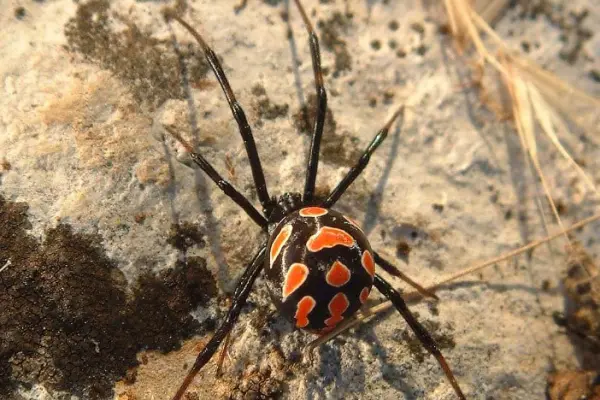
| Scientific name | Latrodectus tredecimguttatus |
| Size | 4-15 mm |
| Identification | thirteen spots on its dorsal abdomen |
| Geographical location | Southern Iberia, southwest and central Asia |
Latrodectus tredecimguttatus, also known as the Mediterranean black widow or European black widow, is a black widow spider species found in the Mediterranean region, ranging from southern Iberia to southwest and central Asia.
It is identified by its thirteen spots on its dorsal abdomen, which are usually red but may also be yellow or orange.
The Mediterranean widow primarily lives in steppes and grasslands and can be a significant problem in areas where grain is harvested by hand.
The female spider has a body length of 7–15 mm, while the male is smaller and reaches 4–7 mm at best. Only the female spider’s bite is dangerous for humans or cattle, as the male cannot penetrate the relatively thick epidermis.
8. Apache jumping spider
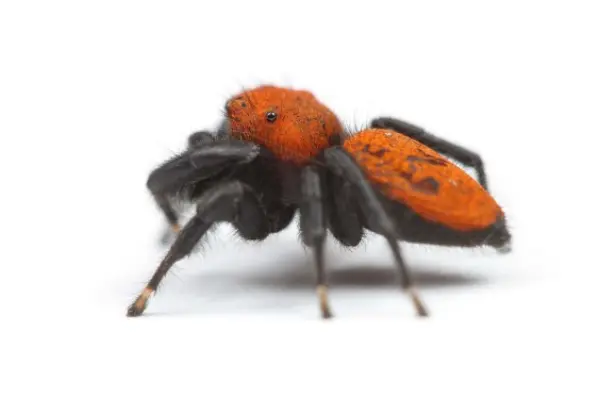
| Scientific name | Phidippus apacheanus |
| Size | 3-22 mm |
| Identification | black stripes on the abdomen |
| Geographical location | United States, Mexico, and Cuba |
Phidippus apacheanus is a large jumping spider belonging to the Salticidae family. Its size ranges from 3.3 mm for small males to 22 mm for large, gravid females.
The female is black with orange on top of the cephalothorax and abdomen, often with a black stripe on the abdomen. The dorsal color is orange, and the underside is black.
The male is similar but has solid coloration and is more often orange. Immature spiders have color patterns similar to adult females, with the first free-living instar being the most difficult to determine.
The first instars of P. apacheanus have a black body and distal leg segments.
9. Regal jumping spider
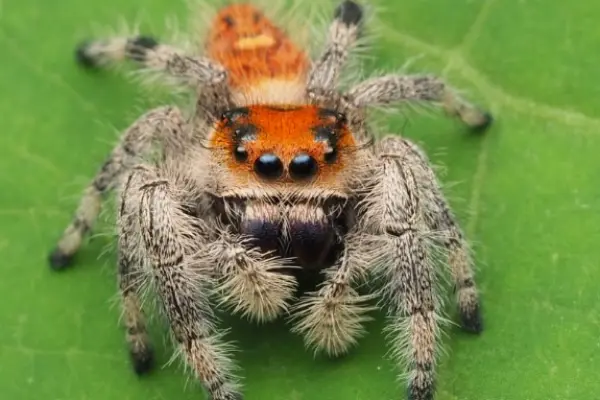
| Scientific name | Phidippus regius |
| Size | 22 mm |
| Identification | black patterns across the dorsum |
| Geographical location | southeastern U.S., the Greater Antilles, Florida, and the Bahamas |
The Regla jumping spiders have distinct coloring differences between males and females. Males are mostly black, while females have an orange ground color on the cephalothorax and abdomen.
This orange female is dominant across the range, with darker orange nuances and black patterns across the dorsum.
Gray and black sections are also specific to the orange female’s legs. Females can also jump, using jumping techniques to ambush prey like small insects.
10. Orange ant-mimic sac spider
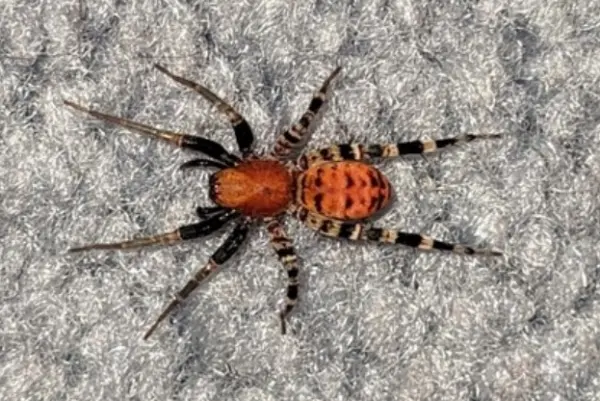
| Scientific name | Castianeira amoena |
| Size | 9 mm |
| Identification | orange abdomen with horizontal black strips |
| Geographical location | The United States and Mexico |
The Castianeira Amoena spider, part of the Corinnidae spider family, is known for its aposematism, resembling tigers with black stripes on its abdomen.
This orange and black spider has an orange abdomen with black strips over it. Despite its stinging bite, it doesn’t kill humans. Spiderlings use webs for flight and silk threads for protection.
11. Guatemalan Tiger rump Tarantula
| Scientific name | Davus pentaloris |
| Size | 100-200 mm |
| Identification | orange markings on its abdomen |
| Geographical location | Mexico, Guatemala, and Panama |
The Guatemalan Tiger Rump is a giant, colorful arboreal tarantula native to central and southern Guatemala, is a popular hobby due to its docile nature, hardiness, and beautiful coloration.
Its name comes from its distinctive black and orange markings on its abdomen, which resemble tiger stripes. Adult females can reach up to 8 inches, while males are slightly smaller.
12. Scorpion spider
| Scientific name | Platyoides |
| Size | 3.3-9 mm |
| Identification | Black abdomen and cephalothorax |
| Geographical location | sub-Saharan Africa, Madagascar, Réunion, Aldabra, and the Canary Islands |
Platyoides is a spider genus found in sub-Saharan Africa, Madagascar, Réunion, Aldabra, and the Canary Islands. Its members are known as scorpion spiders and have a sexually dimorphic body size, with females being larger than males.
The genus is notable for its flat back and unique ability to flatten its abdomen due to a genetic predisposition. New research techniques, such as scanning electron microscopy, have helped distinguish between different species.
The genus is known for its orange carapace around the mouth, pale, ashy gray anterior side, triangular teeth on their upper margins, and elongation of the fourth trochanter. The spiders measure 9 mm in size with a 3.6 mm carapace.
Are orange and black spider venomous?
As some of the orange and black spider species are venomous, let’s have a look at who they are. Generally, most of these spiders, such as the Bold Jumping Spider and the Orange Pumpkin Spider, exhibit low toxicity, posing minimal threat to humans.
However, it’s essential to note that the Ladybird Spider (Eresus sandaliatus) falls into the mild venom category, suggesting caution during encounters. On the more potent side, the Mediterranean Black Widow Spider (Latrodectus tredecimguttatus) is considered highly venomous, with a toxicity level ranging from moderate to high.
While encounters with these spiders are not typically dangerous, it’s advisable to exercise caution and awareness, especially in regions where these spiders are prevalent.
Conclusion:
These are some of the orange and black spiders. All of them have a beautiful color combination. Each of them has some distinctive features that make them special in their own way.
Although many have an aggressive nature, their bite can cause death. But it doesn’t apply to whole spider species. Some are really friendly with humans. Many of them look cute, and their tiny size contributes more to their cuteness.
Now it’s time to say goodbye. Today we learn about the orange and black spider species. I am hoping that it will help you. We will be back with some more informative articles based on the animal kingdom. Till then, stay tuned to HowItSee.
FAQs:
Q: Where do orange and black spiders typically inhabit?
Ans: Orange and black spiders inhabit forests, parks, and green areas. They aren’t overly common but can be found in various geographical locations.
Q: Are all orange and black spiders venomous?
Ans: Some orange and black spiders possess venom, while others are harmless. It’s crucial to exercise caution and identify specific species if encountered.
Q: What are some distinctive characteristics of the Bold Jumping Spider?
Ans: The Bold Jumping Spider (Phidippus audax) features an ovoid abdomen, round cephalothorax, and distinct orange triangles on its abdomen. Adult females range from 8–15 mm.
Q: Which orange and black spider is recognized as the Pumpkin Spider?
Ans: The Pumpkin Spider, scientifically known as Araneus marmoreus, is a marbled orb-weaver with a unique pattern of orange and black colors.
Q: What makes the Ladybird Spider unique?
Ans: The Ladybird Spider (Eresus sandaliatus) is notable for its male coloration, showcasing a bright orange back with four large and two small ebony spots. Females are jet-black and smaller.
Q: Where is the Mexican Fireleg spider indigenous to?
Ans: The Mexican Fireleg (Brachypelma boehmei) is a tarantula native to Mexico, specifically in Guerrero state. It boasts dramatic orange and black coloration.
Q: What distinguishes the Mediterranean Black Widow Spider?
Ans: The Mediterranean Black Widow Spider (Latrodectus tredecimguttatus) is identified by thirteen spots on its dorsal abdomen, which can be red, yellow, or orange. Only the female’s bite poses a danger to humans.
Q: What are the distinctive features of the Apache Jumping Spider?
Ans: The Apache Jumping Spider (Phidippus apacheanus) has black stripes on its abdomen. Females are black with orange on top, while males more frequently exhibit orange coloration.
Q: How does the Orange Ant-mimic Sac Spider defend itself?
Ans: The Orange Ant-mimic Sac Spider (Castianeira amoena) possesses an orange abdomen with horizontal black stripes. Despite its stinging bite, it doesn’t pose a threat to humans.
Q: Where is the Guatemalan Tiger Rump Tarantula located?
Ans: The Guatemalan Tiger Rump Tarantula (Davus pentaloris) is native to Mexico, Guatemala, and Panama. It is known for its distinctive orange markings on its abdomen.
Also Read:

As a content writer, I like to write about different niches. I have a curiosity about nature and animals. And like to learn about them. Through my writing, I like to share my experience and knowledge with you. I hope you are enjoying it too.
